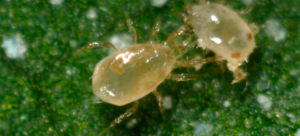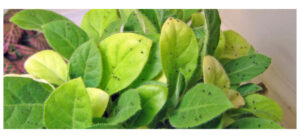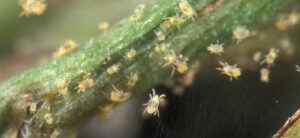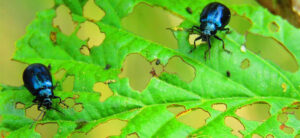
If you are dealing with fungus gnat or thrip infestation, the Stratiolaelaps Scimitus might be your solution.
Read our blog below to get more information about these beneficial mites, how they can help your pest issues, and how to purchase and use them in your garden.
What is the Stratiolaelaps Scimitus
The predatory mite Stratiolaelaps Scimitus, also known as Hypoaspis miles, is been widely used as a biological control agent to control fungus gnats and thrips.
This predatory mite typically inhabits the top inch of the soil surface. It feeds on soil-dwelling stages of fungus gnats, thrips, and other insect pests that cause serious damage to many important crops grown in greenhouses, nurseries, crop fields, and poultry.
These preventative control mites are so small that they are hardly visible to the naked eye. Adults are clear-brown to tan-colored and are about 0.8- 1.0 mm in size.
Hypoaspis consume 1-5 prey per day and can survive as a scavenger by feeding on algae and plant debris. These biological control mites can survive a variety of conditions besides flooding. They can endure mild winters but are inactive below 57 degrees F.
Benefits Of These Predatory Mites In The Garden
Stratiolaelaps scimitus is particularly appreciated for being a safe and environmentally friendly pest control method. Unlike chemical pesticides, these mites do not pose a risk to humans, pets, or beneficial insects such as bees.
These soil-dwelling mites are the ideal choice for organic farming and sustainable gardening practices.
Farmers and gardeners often introduce these fungus gnat predators into their soil to enhance the natural ecosystem and maintain a healthy balance. This practice not only helps in effective pest management but also promotes the growth of healthier, more robust plants.
By using these mites, growers can reduce their reliance on chemical treatments, contributing to a more eco-friendly and sustainable approach to agriculture.
Life Cycle Of The Stratiolaelaps Scimitus
The Stratiolaelaps Scimitus has a short but active life cycle, usually no longer than 13-15 days total.
Females generally lay oval-shaped eggs in the soil. In 2-3 days, these eggs hatch into young mites. Then, over about 7-11 days, they grow into adult mites. As adults, they start eating pests in the soil and laying their eggs.
Under a lens, in any given life stage, these predatory mites look similar. Populations of Hypoaspis include both males and females. However, the males are much smaller and seldom seen.
What Do Stratiolaelaps Scimitus Eat
These tiny helpful mites are like nature's pest control. Their main food source is small insects and their larvae, especially fungus gnats and thrips.
These mites are great because they hunt down these pests in the soil, helping to keep your plants healthy and happy without using chemicals.
Target Pests:
Fungus Gnat Larvae, Thrips, Sciarid Flies, Shore Flies, Root Aphids, Bulb Mites, Springtails and Root Mealybugs.
Where To Purchase Beneficial Mites?
Look no further, here at Hydrobulder.com we sell Stratiolaelaps Scimitus as well as other Beneficial Mites from Tip-Top BioControl. These awesome beneficial bugs come in bottles of 12,500, 25,000, or 50,000.
**Live insects from Tip Top Bio & ARBICO Organics Are Expedited To Ensure Your Insects Arrive Quickly & Safely**
Release Rates For The Stratiolaelaps Scimitus
Generally, for smaller areas or light pest problems, use about 10,000 to 20,000 mites per 100 square feet. Furthermore, If the pest issue is more serious, or the area is larger, you might need up to 50,000 mites for the same space.
Remember, these mites work best when released early in the pest cycle and when the soil is a bit moist. This helps them settle in and start their pest-hunting job effectively.
How do you release Stratiolaelaps Scimitus?
First, you want to gently scatter them over the soil where you have a pest problem. These predatory mites love damp places, so make sure the soil is a bit moist.
Do this early on when you first notice pests, as these mites are great at preventing pests from growing in numbers.
Spread them out evenly, and they'll start working on keeping those pesky pests away. This is a natural and effective way to protect your plants!
Final Thoughts On The Stratiolaelaps Scimitus Soil Mites
If you are having issues with large fungus gnat populations, western flower thrips, or spider mites, these beneficial soil mites might be the solution.
Preventative applications will protect against many of the most common pests that feed on plant roots or have a life cycle in the soil.
Here at Hydrobuilder.com, we sell these awesome little bugs in various amounts from different vendors. If you need help placing an order, call us at 888-815-9763 and one of our experienced growers will help you out.

















